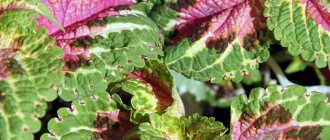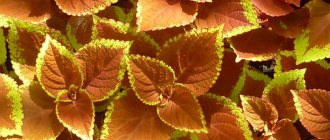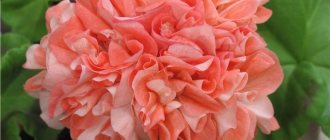Coleus as a crop has been developing relatively recently; in the 19th century, its seeds were brought to Europe from Indonesia, and it came to Russia much later. Today, its popularity is gaining momentum in the flowerbeds of many gardeners as an annual plant. Despite the fact that shrubs are grown in gardens, flower beds and balconies, it can also be an indoor perennial shrub.
This article is dedicated to the amazing “Kleos”, which translated from ancient Greek sounds like “Case”. This name was formed due to the structure of the stamen filaments, which visually form something like a case. The article touches on all the subtleties about Coleus: reproduction, cultivation, care, features and even beneficial properties when used in folk medicine.
Description of the flower
Coleus is also known as Coleus, but amateur gardeners periodically come up with other different names for it. Some call it “Nettle” because of the external similarity of the leaves; they are as pointed as those of nettles, while others, for its simplicity and unpretentiousness, give it the name “Corton for the poor.”
Visually, the bush is represented by many stems that are woody at the base; they are very strong and have a clear texture. The vertically growing stems of the bush are covered with brightly colored leaves, which depend on the varieties of the genus and variety. All varieties have different colors, perhaps no plant can compete with Coleus in the versatility of color shades. In its varieties, the only thing missing is probably blue; there are many other colors.
Over time, it becomes lush and voluminous; the vegetation quickly grows and fills all the free space in the flowerbed, creating a beautiful flower meadow. At home, it does not grow more than 1 meter, which cannot be said about those grown in warm southern countries.
How to form coleus (video)
- If brown spots appear on the leaves, this indicates that the air in the room is too dry. Using special humidifiers you can correct this problem. You can also simply spray the plant with a spray bottle more often.
- If the lower leaves fall off and other leaves have lost their bright color, this indicates that the plant does not have enough mineral fertilizers. In addition, the bare lower part of the stem can cause untimely pruning of coleus. Timely implementation of these procedures will allow the plant to grow lush and healthy in the pot.
- The cause of plant rotting may be poor-quality soil or soil. In this case, the window resident can be saved by pruning and planting new cuttings.
Growing coleus will not be difficult if you follow all the instructions and create optimal conditions for its reproduction and development. Timely care and watering, fertilizing with minerals and useful components, pruning and pinching stems will provide beautiful compositions in flower pots or in the garden.
Peculiarities
Coleus occupies a special place among ornamental crops, as it has multifaceted and very multi-colored foliage, rich in chic color. In addition to traditional green, there are red, burgundy, yellow, purple and other colors. They are very bright and colorful, and may have edges around the edges or stripes and spots in the middle. Thanks to the color shades, which are very eye-catching, it is possible at first glance to distinguish the bush from neighboring flowers in the flowerbed. In nature, there are more than 150 species and varieties of plants that are created by nature or introduced in a hybrid way.
The universal purpose adds features for growing this crop. They are grown with equal success both indoors and in the landscape. The rich colors of the crop go well with club flower beds and adequately emphasize the garden design.
Peduncles can appear from March to late autumn, and in indoor conditions even in winter. The inflorescence has small spike-shaped flowers, most often blue or light blue, they are not very attractive and do not carry any benefits.
Landing
Proper planting plays an important role for the growth and development of the bush in the future.
Since Coleus is a very heat-loving flower, it is planted in the warm season in well-moistened soil. For drainage, place a layer of expanded clay on the bottom of the pot. The roots are placed in the soil so that they are well covered with it; the growing point is not covered.
After planting, you should not expose the pot to the sun; to adapt the root system, you need to spend some time in a shaded place.
Planting methods
Landing is carried out in only 2 ways:
- Planting with seeds.
- By cuttings.
Getting a lush designer bush is a matter of time. You just need to trim and pinch it in a timely manner, giving it shape, and use the cuttings for propagation.
Timing
The popularity of the plant lies in its unpretentiousness; it is completely undemanding in care. Any amateur gardener, even a beginner, can easily grow it.
Coleus cultivation is recommended in the spring, so that the bush begins to grow and delights with its abundance and splendor in the summer, in June. If grown from seeds, it is better to sow them in March in special plastic or wooden seedling boxes. But sowing seeds directly in open ground, as well as planting seedlings, is best done by the end of May, when cold weather is no longer expected.
Do not forget that this crop is very heat-loving; any low temperatures reaching below +8 degrees lead to inhibition of development and wilting of the bush.
Soil selection
Any fertile soil is suitable for planting and growing; ideally, for abundant and beautiful growth, the soil should be sufficiently mineralized and fertilized.
You should not plant a flower in an open, unprotected area exposed to wind. The shoots of the plant will stretch, and having reached a height, they will begin to fall and break under the influence of the wind. This will spoil the bush and give the flowerbed a discreet, unkempt look.
Coleus - flowers for landscape design
A herbaceous evergreen shrub valued for its multicolored appearance. The attractive plant, better known as nettle, is believed to have originated in Africa, although some species have been discovered in Asian countries.
A flower bed with different varieties of coleus looks just great
The height of decorative coleus varies from 15 to 80 cm, the main species difference being the rectangular translucent succulent stem. The foliage is velvety, with serrated edges. It is she who serves as decoration for flower beds. This flower looks very attractive and colorful.
This plant with a stunning appearance will take its rightful place in your garden collection.
The heat-loving perennial crop “coleus” began to be grown in open ground as an annual after the emergence of hybrids that were resistant to the weather conditions of the middle zone. Selected species are much brighter than their wild relatives. More than 20 species are known with variegated multi-colored colors from rich lemon yellow to dark purple. The flower amazes with the beauty of its stripes, spots, variety and combination of shades:
- Pink colour;
- red;
- carmine;
- yellow from lemon to dark;
- green;
- brown;
- purple to blue-black.
The color of coleus leaves largely depends on the amount of sunlight.
Coleus often change leaf color depending on the season. For example, this is what the Wisard Velvet red variety looks like at the beginning of summer
And this is what the same variety looks like at the end of the warm season
Breeders managed to obtain plants with different leaf shapes:
- terry “nettle” with fringe along the edges of the leaves looks gorgeous;
- varieties with tuberous leaf blades of teardrop-shaped and triangular shape are cultivated;
- grow large-leaved coleus;
- The unusual round shape of the leaf expands the possibilities of using coleus in flower arrangements.
The habit of the bush has changed. Compact, dense crowns have acquired a spherical and pyramidal shape. Short and tall hybrids have been bred.
Among the coleus there are specimens with very interesting shapes of leaf blades (the Butterfly variety is shown in the photo)
The variety “Russian vegetable garden” is distinguished by large leaves with an original color
The amazingly beautiful coloring has become resistant to direct sunlight, does not fade or fade. It was possible to change the flowering time of coleus. Inexpressive, spike-shaped “tails” with pale blue-violet buds have become smaller. Coleus in landscape design photos have become quite popular not only in the southern regions of the country, but also in the temperate climate zone.
The flowering of coleus cannot be called a decorative process, so the flower stalks are usually removed
For abundant growth of peduncle leaves in coleus, it is necessary to remove peduncles, which take up a significant part of the nutritional resources.
Hanging varieties of coleus are grown in hanging pots
Home care rules
Coleus does not require complicated care at home. In warm room temperatures it may be grown as a perennial flower in pots and planters. Flowering continues in the fall, growth activity continues in the spring, and dormancy occurs in the winter, cold period.
Growing at home does not give the gardener much trouble, but like any vegetation, for beautiful growth, it needs systematic care.
Lighting
It is photophilous and needs a sufficient amount of lighting; you should choose a fairly suitable place for it, but not under intense sunlight.
With excessive exposure to the sun, the bush loses its brightness and slows down its growth.
If there is not enough light, the bush begins to stretch and simultaneously shed its leaves, which leads to an unpresentable appearance.
Air humidity
Garden crops from warm countries simply need moisture and are completely intolerant of drought. If you organize regular watering of the soil and periodically moisten the leaves by spraying from a polyvilizer, then the shrub will not remain indifferent and will definitely reward you with the beautiful, rich and noble color of the leaves.
Temperature
Favorable temperature for growth is from 19 to 24 degrees.
The bush treats temperature changes normally, unless of course they reach strong jumps and cold air flow, including drafts.
Crown formation
To form a compact crown, the bushes are pruned several times a season. To grow carpet, cut to a height of 15 cm.
Watering rules
It loves moist soil and grows and develops comfortably in it.
Watering the vegetation in the pots is carried out directly into the ground at the moment when the top layer dries. It is also necessary to moisten the leaves abundantly.
Coleus propagation
Reproduction of Coleus is not difficult, so gardeners, to grow it in the garden, simply dig up 1-2 bushes and move them indoors for the winter, so that they can be planted in flower beds again next year.
The root system of the plant is dense and dense, it easily takes root in a new place.
Propagation by seeds
Propagation by seeds is carried out in the spring. Sow the seeds in flower boxes with prepared, fertilized soil and cover with polyethylene or glass. Further care consists of systematic watering and ventilation.
Seed germination is almost 100%, occurring 10-15 days after sowing.
Cuttings
Cuttings are carried out from the tops of old shoots. Place the cuts in water until roots appear on the stems. After the root system has grown, the sprout can be planted in the ground, in a separate cup, or directly in a small pot.
Seedling
Since Koleus is rich in a powerful, dense root system, each sprout is grown in separate cups for ease of replanting. As soon as the shoots reach a height of 15-20 cm, they can be moved into open ground, into a separate hole. The distance between the holes should be about 30 cm.
Using coleus in various compositions
Bizarre patterns on the leaves make it possible for coleus to participate in the most unusual combinations: with summer flowers in flower beds, and in pots, containers on the terrace, balcony.
Its bright red outfit harmonizes perfectly with lilac ageratum, green plectranthus, bush argyrantemum, and lemon - with white and purple balsams. In landscape design, creeping, ampelous, large-leaved, miniature (dwarf) varieties are used. Variety 'Superbus' (brown-red leaves with a greenish border) hanging for hanging baskets. Dwarfs 'Colosseus Nana' (up to 30 cm high, brightly colored leaves), 'Sabre' (up to 15 cm high) seem to be created for containers. Coleus are good in flower beds, ridges, and mixborders.
The dark leaves of coleus look very aristocratic, sometimes it seems that something mystical emanates from them. To emphasize this mysterious beauty, such plants are planted against the background of perennials with white, bright blue, as well as light and intense pink flowers. On the contrary, coleus with light, lemon-colored leaves can brighten shady areas.
The most popular varieties (types)
Today there are numerous known species, varieties and varieties. The variety is full of bush, dwarf and ampelous forms.
The genus Coleus Blume has received wide distribution and recognition among flower growers for its aesthetic value. In appearance, it resembles nettles with brightly colored multi-colored leaves. The height of the plant is not constant, but can reach 1 meter. For growing indoors, it is recommended to select low-growing varieties. Photo:
Photo: Coleus Blume
Dark Chocolate
A spectacular and unusual variety with a dark brown color. Very soft and velvety foliage.
Photo: Dark Chocolate
Wizard Jade
The variety is known for its white core with a wide, bright border in shades of green and yellow. If you use it in combination with Coleus of other shades, you get a gorgeous meadow of color in the flowerbed.
Photo: Wizard
Black Dragon
It is a dwarf bush, the structure of which resembles nettles. This is one of the few species in whose family there is a variety of almost black and very dark leaves.
Photo: Black Dragon
Pomilus
The variety is known for its dwarf size and bright, contrasting colors. Velvet of the night
Rich in dark shades of red, brown and purple with purple veins, the leaf shape has distinctive jagged edges.
Photo: Coleus Blume
Fantasy
A hybrid variety with twisted leaves.
Photo: Fantastic
Coleus scarlet
A small flower with a bright scarlet hue, which is emphasized along the contour by a narrow white border.
Photo: Wizard Scarlet
Varieties of Coleus Blume
Numerous varieties based on Coleus Blume are used in cultivation. Here are some of them.
Coleus Blume, variety 'Candidum'
The leaves are green with yellow spots.
Coleus Blume, variety 'Sabre'
A dwarf variety, up to 15 cm high, mosaic leaves with a pinkish-cherry center and a greenish-yellow irregular border.
Coleus Blume, variety 'Salmon Lace'
Leaves with a reddish center and a wide green border.
Coleus Blume, variety 'Wizard Scarlett'
The leaves are red with a thin yellow border.
Coleus Blume, variety 'Wizard Pineapple'
Leaves are bicolor, cherry green.
Coleus blumei var. verschaffeltii
The leaves are large, up to 20 cm long, velvety red with a green border.
Pests and diseases
The leaves, starting from the ends, may turn yellow and dry out, this indicates a lack of moisture for adequate nutrition and growth. When watering is resumed and thoroughly moistened, the plant will quickly recover and regain its former charm and colors. With a lack of lighting, the color of the flower fades and becomes dull.
Indoor flowers are more susceptible to pests than outdoor flowers. The following may appear on the reverse side of the leaves: aphids, mites, scale insects, and whiteflies.
To protect and prevent the appearance of diseases and pests, it is necessary to periodically inspect the bush, and if detected, immediately remove the infected area and rinse the leaves with water, you can use insecticidal treatment.











